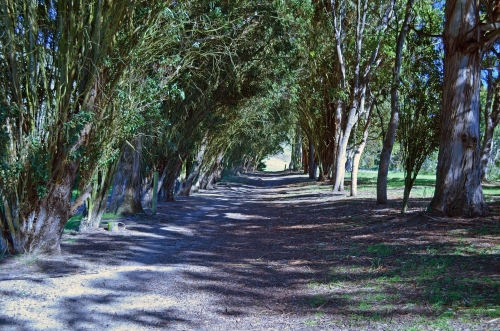Reduce global warming, plant a tree
September 4, 2016
OPINION by ALLAN COOPER
In urban “heat islands,” vast stretches of asphalt magnify and reflect sun, sending CO2 directly skyward and creating “dead zones” below. Adding street trees can actually lower summer temperatures through evaporative cooling. A tree forms an oasis of shade, provides wildlife habitat, and improves air quality. Forest soil acts as a sponge for water and deters runoff thereby recharging our aquifers.
But, sadly, on the West Coast last year, over 10 million acres of trees or 15,625 square miles were burned. In California nearly 58 million trees are near death due to drought conditions and another 888 million trees over an area of 41,000 square miles in California are drought stressed.
Stressed trees are a target for the dreaded bark beetle. All of this contributes to global warming because of the carbon produced from fires and dying trees.
Because of this, every effort should be made to preserve and add to our existing tree canopy.
Studies have identified several optimal tree species for carbon storage. When choosing trees to plant, consider:
- Long-lived trees that can keep carbon stored for generations without releasing it in decomposition.
- Fast growing trees that store the most carbon during their first decades, often a tree’s most productive period.
- Large leaves and wide crowns enable maximum photosynthesis.
- Native species will thrive in your soil and best support local wildlife.
- Low-maintenance, disease-resistant species will do better without greenhouse-gas-producing fertilizers and equipment.
Among the trees listed on San Luis Obispo’s Street Tree Master List are reliable and versatile star-performers for carbon sequestration. They include the Tulip Tree (the top carbon storer), the Red Maple (can trap nearly 25,000 pounds of CO2 in a 55 year period), the Coast, Live, Valley, Cork and Holly Oaks (these have adapted to thrive in many climates, provide food and shelter to wildlife), the California Sycamore (very tolerant of pollution and root-cramping, resistant to cold and disease) and the Common Horse Chestnut (its domed top provides exceptional shade which offers passive cooling benefits). However, the City should consider other outstanding carbon storers not on this list such as the Red Mulberry (provides the added benefit of seasonal fruit for wildlife), the Red Pine (the most carbon-effective conifer), the Norfolk Island Pine, the Italian Stone Pine, and the Black Walnut.
Short of growth in perpetuity, reforestation with long-lived trees (i.e., greater than 100 years) will sequester carbon for a more graduated release, minimizing impact during the expected carbon crisis of the 21st century.
Bringing all of this closer to home, an example of what not to do, is the proposed removal of 48 old-growth trees at 71 Palomar to make way for a 33 unit apartment complex. Slated for removal – and among those that are remarkably long-lived – are two Norfolk Island Pines which can live on average to 150 years though there is mention of a 1,000 year old Norfolk Island Pine in Chile, 18 Eucalyptus Globulus where in temperate climates they can live 400-500 years, one Italian Stone pine where in Britain’s Kew Gardens there is a record of one that attained an age of 300 years, two Olive Trees, a tree that can live well over 500 years and still bear fruit and one Coast Live Oak, where in Temecula, Calif. there is a specimen that is over 2,000 years old.
Many of these trees are also low-maintenance, disease-resistant species that will do better without greenhouse-gas-producing fertilizers and equipment. Norfolk Island pines are particularly tolerant of a variety of soils and windy conditions. The Italian Stone Pine is drought-tolerant, rarely bothered by deer and is not highly susceptible to many diseases. Stone pines thrive on the West Coast, especially in California where temperatures do not fluctuate severely. Tolerant of saltwater spray, this pine isn’t picky about where it lays down its roots and will grow in acidic and alkaline soils. This tree neither has pitch canker nor does it have root rot.
Then there are the species that will thrive in your soil and support local wildlife. Eucalyptus Globulos flowers are mainly pollinated by insects, but birds and small mammals may also act as pollinating agents. In fact, Eucalyptus is particularly valuable as bee pasture, because it blooms year-round. The hollows in older Eucalyptus trees also provide homes to animals and birds. Birders have identified over 40 species of birds in Sutro Forest. At Jepson Prairie Preserve, CA, Swainson’s hawk and yellow warblers, both of which are “Blue Listed” species of concern, nest in the trees.
At Pescadero Creek County Park, south of San Francisco along the coast of California, great blue herons and egrets use the trees to build their rookeries. As for European Olive Trees, fruit and seed eating birds, including finches, will steal fruit from these trees and even olives that aren’t yet ripe. The acorns of the Coast Live Oak feed everything from squirrels and deer to wild turkeys and black bears. More than 500 types of butterflies and moths are attracted to this host plant.
So the old adage “think globally and act locally” applies here. We urge you to consider the health of the entire planet while taking action in your own backyard.
We can start with the 71 Palomar project where the developer states: “The proposed project includes a conceptual landscape plan showing the removal of all of the existing vegetation with the exception of a 28-inch diameter eucalyptus tree at the southwest corner of the site and a 74-inch palm tree midway along the east property boundary.”
The trees proposed for removal sustain wildlife and are long-lived, disease-resistant, and healthy specimens. They add beauty to the north part of San Luis Obispo and are accessible for viewing and enjoyment by the public. But most importantly these trees are playing a vital role in carbon sequestration.
However, if you are not inclined to engage in the public arena, then please, depending on the size of your property, plant one or two trees in your own front or back yard, and preferably one of the tree types mentioned above.








The comments below represent the opinion of the writer and do not represent the views or policies of CalCoastNews.com. Please address the Policies, events and arguments, not the person. Constructive debate is good; mockery, taunting, and name calling is not. Comment Guidelines